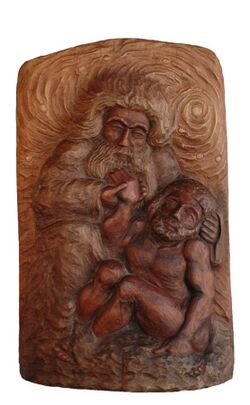Religion:Creation of man from clay
From HandWiki
The "creation of man from clay" is a miraculous birth theme that recurs throughout world religions and literature. Examples include:
- In Greek mythology, according to Pseudo-Apollodorus (Bibliotheca, 1.7.1), Prometheus molded men out of water and earth.
- In Sumerian mythology the gods Enki or Enlil create a servant of the gods, humankind, out of clay and blood (see Enki and the Making of Man). In another Sumerian story, both Enki and Ninmah create humans from the clay of the Abzu, the fresh water of the underground. They take turns in creating and decreeing the fate of the humans.[1]
- In the Epic of Gilgamesh Enkidu is created by the goddess Aruru out of clay to be a partner for Gilgamesh, "mighty in strength".
- According to Egyptian mythology the god Khnum creates human children from clay before placing them into their mother's womb.[2]
- According to Chinese mythology (see Chu Ci and Imperial Readings of the Taiping Era), Nüwa molded figures from the yellow earth, giving them life and the ability to bear children.
- In the Babylonian creation epic Enuma Elish, the goddess Ninhursag created humans from clay.
- According to Hindu mythology the mother of Ganesh, Parvati, made Ganesh from clay and turned the clay into flesh and blood.
- According to some Laotian folk religion, there are stories of humans created from mud or clay.
- The Yoruba culture holds that the god Obatala likewise created the human race from clay.
- According to Genesis 2:7 "And the Lord God formed man of the dust of the ground, and breathed into his nostrils the breath of life; and man became a living soul".
- According to the Qur'an[23:12–15], God created man from clay.
- The Māori people believe that Tāne Mahuta, god of the forest, created the first woman out of clay and breathed life into her.
- According to Inca mythology the creator god Viracocha formed humans from clay on his second attempt at creating living creatures.
- According to some Native American beliefs, the Earth-maker formed the figure of many men and women, which he dried in the sun and into which he breathed life.
- In American culture, Wonder Woman was sculpted from clay by her mother Hippolyta and given life by the Greek gods.
- In Norse culture humans are made from sand in tree trunks.
- The role of clay minerals in the origin of life is suggested scientifically because of the ordered arrangement of the clay mineral particles, the large adsorption capacity, shielding against ultraviolet radiation, ability to concentrate organic chemicals and ability to serve as polymerization templates. Clay minerals were proposed as possible genetic material. Clay minerals act as very efficient catalysts in the polymerization of amino acids and nucleotides, thus supporting the possible existence of an RNA world preceding a cellular world. RNA adsorbed to clay minerals can be encapsulated within vesicles. Once formed, such vesicles could grow by incorporating fatty acids and divide, thus mediating vesicle replication through cycles of growth and division. The data obtained so far suggest that clay minerals played an active role in the abiotic origin of life.[3]
References
- ↑ http://etcsl.orinst.ox.ac.uk/section1/tr112.htm
- ↑ http://www.britannica.com/EBchecked/topic/316758/Khnum
- ↑ Brack, A. (2013-01-01), Bergaya, Faïza; Lagaly, Gerhard, eds., "Chapter 10.4 - Clay Minerals and the Origin of Life", Developments in Clay Science, Handbook of Clay Science (Elsevier) 5: pp. 507–521, http://www.sciencedirect.com/science/article/pii/B978008098258800016X, retrieved 2019-08-19
- Bellows, Henry Adams (Trans.) (1936). The Poetic Edda. Princeton University Press. New York: The American-Scandinavian Foundation.
- Byock, Jesse (Trans.) (2006). The Prose Edda. Penguin Classics. ISBN:0-14-044755-5
- Davidson, H. R. Ellis (1975). Scandinavian Mythology. Paul Hamlyn. ISBN:0-600-03637-5
- Hultgård, Anders (2006). "The Askr and Embla Myth in a Comparative Perspective". In Andrén, Anders; Jennbert, Kristina; Raudvere, Catharina (editors).Old Norse Religion in Long-term Perspectives. Nordic Academic Press. ISBN:91-89116-81-X
- Dronke, Ursula (Trans.) (1997). The Poetic Edda: Volume II: Mythological Poems. Oxford University Press. ISBN:0-19-811181-9
- Larrington, Carolyne (Trans.) (1999). The Poetic Edda. Oxford World's Classics. ISBN:0-19-283946-2
- Lindow, John (2001). Norse Mythology: A Guide to the Gods, Heroes, Rituals, and Beliefs. Oxford University Press. ISBN:0-19-515382-0
- Orchard, Andy (1997). Dictionary of Norse Myth and Legend. Cassell. ISBN:0-304-34520-2
- Puhvel, Jaan (1989 [1987]). Comparative Mythology. Johns Hopkins University Press. ISBN:0-8018-3938-6
- Schach, Paul (1985). "Some Thoughts on Völuspá" as collected in Glendinning, R. J. Bessason, Heraldur (Editors). Edda: a Collection of Essays. University of Manitoba Press. ISBN:0-88755-616-7
- Simek, Rudolf (2007) translated by Angela Hall. Dictionary of Northern Mythology. D.S. Brewer. ISBN:0-85991-513-1
- Thorpe, Benjamin (Trans.) (1907). The Elder Edda of Saemund Sigfusson. Norrœna Society.
- Thorpe, Benjamin (Trans.) (1866). Edda Sæmundar Hinns Frôða: The Edda of Sæmund the Learned. Part I. London: Trübner & Co.


